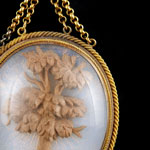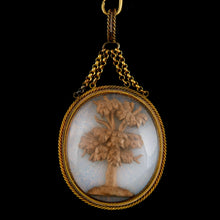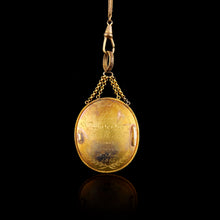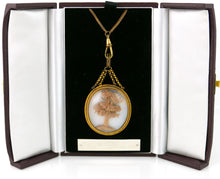The Waterloo Elm Pendant - ‘Halkett’s Gratitude’, 1815-18
Adding product to your cart
4.5cm (1.77in) x 4cm (1.57in)
Gilt metal oval glazed pendant containing a miniature relief carving of The Tree of Observation, laid down on mother of pearl, the reverse of the closed back inscribed ‘Part of the Tree of Observation / Wellington / Waterloo / Halkett’s / Gratitude / 18th June 1815’. Contained in a modern presentation display case with easel back.
The Waterloo Elm, or Tree of Observation, stood at the centre of Wellington’s line with the Allied army stretching away 1500 metres to the east and west. It was the post of the Duke of Wellington’s personal staff for much of the Battle of Waterloo (18 June 1815). It was located just south west of the intersection of the sunken lane and the Genappe–Brussels main road. Wellington ranged widely over the battlefield during the course of the day but it was from the elm tree that he directed the defence of Hougomont, witnessed the attack of Picton’s hard pressed division, and gave the signal for the general advance of the army that sealed the Allied victory at the end of the day. Consequently the tree became a totem for veterans and early tourists in the aftermath of battle.
There were two Halketts at Waterloo. Hugh, Baron von Halkett (1783-1863) and his younger brother Colin Halkett (1774-1856). Of Scottish descent, both were veterans of the Peninsula and highly effective soldiers of the King's German Legion. At Waterloo Hugh commanded four Landwehr battalions of the 3rd Hanoverian Brigade, in the rear of the Anglo-Allied right while Colin commanded 5th British Brigade in General von Alten’s 3rd Division which held the British centre throughout the day. Colin’s position was in the hottest part of the action and was the closest of the two brothers to the elm tree and Wellington’s staff and is thus more likely to be the Halkett referenced on the pendant. Colin Halkett’s brigade was badly mauled by cavalry at Quatre Bras as the result of an unfortunate order from the Prince of Orange. It was rallied by Halkett personally holding aloft the King’s Colour of the 33rd Foot. At Waterloo his brigade was under fire throughout the day. His numbers shrank so much that when attacked by cavalry the brigade formed only two squares, 30th Foot & 73rd Highlanders and 33rd Foot & 69th Foot.
Colin had four horses shot under him and was wounded twice. He was nevertheless denied any respite by Wellington, being told at a moment of particular crisis by the Duke, ’Every Englishman on the field must die on the spot we now occupy.' At the most critical moment of the day Halkett ordered his brigade out of their squares and into a four deep line to meet the attack of Napoleon’s Imperial Guard. After receiving a volley fired at 40 metres, he ordered a bayonet charge, repulsed the 3e and 4e Grenadiers à Pied but was driven back French Guard artillery firing canister into his ranks. Near panic ensued as the brigade fell back to the shelter of the reverse slope. At that moment Wellington appeared and a sudden rallying cry from one of Halkett’s battalions had the effect of reversing the rout.
The inscription on the present pendant is tantalising and may reasonably be addressed to a survivor of Colin Halkett’s brigade or possibly a relative of the fallen. After the battle the elm tree became prey to souvenir hunters and was soon little more than a stripped trunk. In 1818 English tourist John George Children (b.1777), an Eton and Cambridge educated Librarian in the Department of Antiquities at the British Museum, followed the well trodden path to Mont Saint Jean to ponder the famous elm. His daughter Anna made a sketch of the elm tree (now in the Royal Collection). Mr Children purchased the stripped tree, brought it to England, and commissioned Thomas Chippendale the Younger to make a chair from it which he presented to George IV at Carlton House in 1821. A story that the local farmer, agitated that his crops were annually being laid waste by tourists felled the tree, is harshly commented on by Victor Hugo in his introduction to Les Miserables, when referring to the famous elm - ‘which an Englishman, an enthusiastic vandal, has since bought for two hundred francs, cut down and carried away.’
Apart from the Waterloo Chair in the Royal Collection, other items were made from the elm. These include a reading table (Christies, Lot 140, 10 May 2006), a mineral cabinet and a work table for Anna Children of Halstead Place, Kent (both since lost); a chair for the Duke of Rutland (extant at Belvoir Castle) and another for John Children but given to Wellington in 1837 (now at Apsley House); a wine cooler now in the possession of Wellington College. Smaller items include a gold mounted sliver of elm modelled as miniature sword blade that was owned by Fitzroy Somerset (later 1st Baron Raglan, Military Secretary to the Duke of Wellington at Waterloo, now in the collection of the National Army Museum); and a ducal coronet surmounting the frame of Sir Thomas Lawrence’s portrait miniature of the Duke (sold by Christies as Lot 243, 3 May 1838).
Source: Furniture History Society, Geoffrey de Bellaigue, ‘The Waterloo Elm’, Vol. 14 (1978), pp.14-18.








